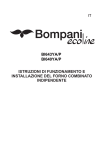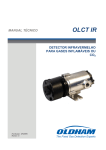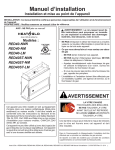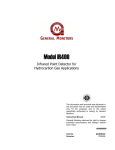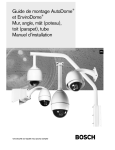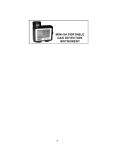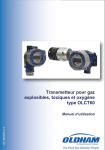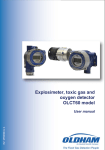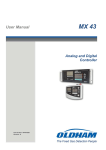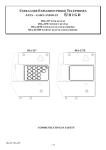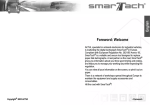Download OLCTIR_rev F_English
Transcript
TECHNICAL MANUAL OLCT IR INFRARED DETECTOR FOR FLAMMABLE GASES OR CO2 Part Number : NPOIRGB Revision : F The Fixed Gas Detection Experts 1 2 User manual GAS DETECTION Thank you for purchasing an OLDHAM instrument. We appreciate your business. We trust that our commitment to the technical excellence of our products will ensure your complete satisfaction. Please read the following document carefully. LIMITATION OF LIABILITY * OLDHAM will not be liable under any circumstances for material losses, personal injury or death resulting in whole or in part from the inappropriate use of this equipment, the installation or storage of this equipment not in conformance with the instructions and warnings presented in this manual and/or not in conformance with current standards and regulations. * OLDHAM neither condones nor authorizes any other company, individual or legal entity to make any claims as to the liability of OLDHAM, even if said company, individual or legal entity is directly involved in the sale of OLDHAM products. * In no event will OLDHAM be liable for any direct or indirect damage including those resulting from the sale and the use of its products IF THOSE PRODUCTS WERE NOT SPECIFIED AND SELECTED BY OLDHAM FOR SUCH USE. OWNERSHIP CLAUSES * The images, blueprints, specifications and information contained in this document belong to OLDHAM. * This information may not be physically, electronically or otherwise reproduced, copied, disclosed, or translated, either in part or in whole, or used in the manufacturing or sale of OLDHAM equipment, nor for any other reason without prior permission from OLDHAM. WARNINGS * This document is not contractual. On behalf of its clients, OLDHAM reserves the right to modify the technical characteristics of its equipment without notice to improve product performance. * CAREFULLY READ THIS DOCUMENT BEFORE USING THE PRODUCT: this document should be carefully read by any individual who has or who will have the authority to use, maintain or repair this equipment. * Any and all warrantees and performance claims will only be valid if the equipment is operated, maintained and repaired in accordance with OLDHAM directives, by OLDHAM personnel or by personnel appointed by OLDHAM. WARRANTY * Five-year return to factory warranty under normal operating conditions on parts and labor; consumable materials excluded (sensors, filters, etc.). 3 DISPOSAL For the preservation, protection and improvement of environmental quality, and for the protection of human health and the prudent and rational utilization of natural resources, the OLCT IR must be disposed of separately from electronic equipment and cannot be disposed of with normal household waste. The user therefore has an obligation to separate the OLCT IR from other waste to ensure that it is recycled safely for the environment.For further details on existing collection sites, contact the local administration or seller of the product. 4 User manual CONTENTS Figure 1 ..................................................................................................................................................................... 0 Figure 2 ..................................................................................................................................................................... 1 Figure 3 ..................................................................................................................................................................... 2 Figure 4 ..................................................................................................................................................................... 3 Figure 5 ..................................................................................................................................................................... 4 1. INTRODUCTION ........................................................................................................................................... 6 2. TECHNICAL SPECIFICATIONS 2.1 (1) ..................................................................................................................... 8 INTERFERENCE OF COMMON GASES ON OLCT IR (CH4 AND HC) .............................................................................. 9 3. INSTALLATION ........................................................................................................................................... 12 4. START UP ................................................................................................................................................... 12 5. MAINTENANCE .......................................................................................................................................... 14 5.1 5.2 CORRECTIVE MAINTENANCE............................................................................................................................. 14 PERIODIC MAINTENANCE ................................................................................................................................ 14 6. LIST OF ACCESSORIES ................................................................................................................................. 18 7. SPECIAL INSTRUCTIONS FOR USE IN ATEX EXPLOSIVE ATMOSPHERES AND FOR FUNCTIONAL SAFETY ...... 20 7.1 7.2 USE IN ATEX EXPLOSIVE ATMOSPHERES............................................................................................................. 20 FUNCTIONAL SAFETY ...................................................................................................................................... 21 8. MARKING: ................................................................................................................................................. 22 9. MANUFACTURER’S DECLARATION OF CONFORMITY ................................................................................. 24 Contents 1 2 User Manuel Ground screw Fastening lug Figure 1 OLCT IR withAvec weather protection coiffe antiprojection Cable gland, M20x1.5, optional (See Special instructions for use in ATEX explosive atmospheres) 0 User Manual REP 1 2 3 4 6 7 8 NBR 1 1 1 1 2 1 1 OPTION 5 1 Figure 2 OLCT IR Exploded view DESIGNATION WEATHER PROTECTION O-RING DIA. DIAM=65x3 LOCKING NUT M5 TERMINAL COVER Ex TERMINAL O-RING DIA DIAM=69x2 LED PCB CABLE GLAND, M20, ARMOURED CABLE OR CABLE GLAND, M20, NON-ARMOURED CABLE REF OFSA 6313862 6136242 6903376 6123723 6152989 6135036 6451495 6343489 6343493 Figure 3 OLCT IR Terminal block LED Magnetic receiver 0V Ser Connection Iout Iout +24VDC 0V +24VDC Output signal in mA (terminal 1 of OLDHAM central units) Power supply 0 V (terminal 2 of OLDHAM central units) Power supply + (terminal 3 of OLDHAM central units) Ser = service (do not use) the electric wires will be equipped with a crimped end 2 User Manual Cable gland M25 x 1.5, optional (See: Special instructions for use in ATEX explosive atmospheres) Ground screw Fastening lug Figure 4 OLCT IR with by-pass adaptor (calibration cup) GAS INLET AND OUTLET BY-PASS ADAPTOR Cable gland, M20 /M25 Bracket (P/N 6322420) Figure 5 Ceiling mount for OLCT IR 4 User Manual 1. INTRODUCTION The OLCT IR gas detector is designed to monitor flammable gases or CO2 concentrations in the ambient air. The infrared technology used by the OLCT IR guarantees extreme detection accuracy. Powered with 24 Vdc, the OLCT IR provides a standard 4-20 mA analog output which is proportional to the measured concentration of gas. It features a non-intrusive calibration that enables calibration in hazardous area without declassifying the zone. The OLCT IR detector can be used in gas and dust explosive atmospheres and meets all of the essential requirements of the ATEX 94/9/EC European Directive and following European EN and international IEC standards: - EN 60079-0:2012 EN 60079-1:2007 EN 60079-7:2007 EN 60079-11:2012 EN 60079-31-2014 IEC 60079-0 (ed.6):2011 IEC 60079-1 (ed.6):2007 IEC 60079-7 (ed.4):2006 IEC 60079-11 (ed.6):2011 IEC 60079-31 (ed.2):2013 Company label The enclosure has two identifier labels, as described below id. Description 1. Manufacturer’s name 2. Type of product 3. ATEX- IECEx Marking 4. CE symbol and the number of the organisation that provided the OLDHAM production quality certification (INERIS ) 4 1 2 6 5. Warning. 6. Maximun ATEX certification temperature (excluding metrological performance) 7. Recycling symbol 8. Detector serial number (S/N). The first two digits (in this case 09) correspond to the year of manufacture (in this case 2009) 9. Thread diameter and pitch for cable inlet User Manual 7 091214Y-903 3 5 6 8 9 Firmplate The OLTC IR is available in various configurations: Methane Version (CH4): - % LEL: optimized for methane detection, standard range is 0-100% LEL (0-5% vol.). The range can be adjusted to 0-4.4% vol. for those who consider this value as the lower explosive limit for methane. - % Vol.: detection of methane from 0 to 100% vol. HC Version: - Optimized for the detection of saturated hydrocarbons (propane, butane, pentane, hexane, ethanol, etc.). The standard range is set in factory: C3H8 – 0 to 100% LEL C4H10 – 0 to 100% LEL C2H6O – 0 to 100% LEL C6H14 – 0 to 100% LEL CO2 Version: - Optimized for CO2 detection from 0 to 3% vol. 1 - Introduction 7 TECHNICAL SPECIFICATIONS(1) 2. Detection method Gases detected (set in factory) (3) Infrared absorption Methane,Propane, Butane, Hexane, Ethanol(2) CO2 Range (typical) 100% LEL CH4, C3H8, C4H10 100% volume CH4 3% volume CO2 Accuracy +/-3% LEL CH4 or +/- 5 % of measurement +/-2% LEL HC or +/- 3 % of measurement Long term stability at operating temperature zero: +/-1 LEL from -25°C to +55°C gain : +/-5% LEL or +/- 10% of measurement Response time without weather protection with weather protection T50 < 7 seconds - T90 < 8 seconds T50 < 10 seconds - T90 < 16 seconds Voltage 16 to 30 VDC Average Consumption 2.5 W typical (max intermittent current = 500 mA) Signal Output Source signal encoded from 0 to 25 mA (non-isolated): 4 to 20 mA: linear and proportional to gas measurement 0 mA: electronic fault or power loss 0.5 mA: dirty optics, temperature is out of specification 1 mA: detector fault 2 mA: calibration mode > 23 mA: out of range Wiring 3-wire shielded cable Load resistance (with OLDHAM controller) 8 Ohm in loop (250 meters with 1.5 mm² core size cable) Max. output load resistance 300 Ohm Cable entry M20 x1.5 (cable gland in option, See special instructions for use in ATEX explosive atmospheres ) Cable diameter Armoured cable: Operating Temperature -25°C to 55°C by default (-50°C to +55°C available upon request) Storage temperature: -50°C to 55°C Electromagnetic Compatibility Complies with EN 50270:06 Types 1 and 2 IP Rating IP 66 – IP 67 ATEX Complies with the European Directive ATEX 94/9/EC and IEC Ex Scheme (see attached declaration) Weight 1.6 Kg Materials INOX 316L Humidity 0 to 99% RH (noncondensing) Pressure influence Measurement: partial pressure Due to the continual improvement of our products, OLDHAM reserves the right to modify the product specifications listed in this document at any time. (2) The majority of organic components comprising C-H bonds (3) Hydrogen is not detected. Saturated hydrocarbons are more sensitive than CH4 (typically 5 to 7 times more), while Unsaturated and Benzenic Hydrocarbons are less sensitive than CH4. Warning: Acetylene and Ammonia have a negative cross sensitivity on the measurement. Above 2,000 ppm acetylene or 10,000 ppm ammonia, the presence of other gases may be masked. User Manual (1) 8 Outer diameter 8.5 to 16 mm Inner diameter 6 to 12mm Unarmoured cable: Inner diameter 6 to 12mm 2.1 Interference of common gases on OLCT IR (CH4 and HC) Any organic molecule with at least one C-H bond except for acetylene can potentially be detected by the OLCT IR, though the sensitivity varies. Note the following: Regardless the detector version, saturated hydrocarbons give a greater response than CH4; The OLTC IR CH4 is more sensitive to CH4 and less sensitive to hydrocarbons than the OLCT IR HC; With regards to the OLCT IR CH4, a signal of 20mA corresponds to 100% LEL CH4 or 20% LEL C3H8 (factor 5); With regards to the OLCT IR HC, a signal of 6.4mA signals corresponds to 100% LEL CH4 or 14% LEL C3H8 value (factor 7); The OLCT IR HC is usually more suitable for the detection of saturated molecules such as alkanes, alcohols, ketones, organic acids, esters and ethers. The OLCT IR CH4 is usually more suitable for the detection of unsaturated hydrocarbons such as alkenes and aromatics with H-C bonds although they give less signal than CH4 As an example, see below the response curves for common HCs (accuracy is +/-15 %). OLCT IR CH4 % %LEL LELCH4 CH4 OLCTIR Interference of the mainalcanes alkanes&and alcohols OLCTIRCH4 CH4 calibrated calibré CHto Interférence des principaux alcools 4 : CH4: 100,0 90,0 80,0 70,0 Méthane MethaneCH4 CH4 Propane PropaneC3H8 C3H8 Butane ButaneC4H10 C4H10 Hexane Hexane C6H14 C6H14 Nonane Nonane C9H20 C9H20 Cy clohexane C6H10 Cyclohexane Méthanol Methanol CH3OH CH3OH Ethanol Ethanol C2H6O C2H6O 60,0 50,0 40,0 30,0 20,0 10,0 0,0 0,0 10,0 20,0 30,0 40,0 50,0 60,0 70,0 80,0 90,0 100,0 Conc Conc [% LEL] 2 – Technical specifications 9 OLCT IR HC (propane calibration) OLCT : Interference of the main alkanes alcohols OLCT IR IR HC HC calibrated calibré C3Hto Interférence des principaux alcanes && alcools 8 :C3H8 % LEL C3H8 C3 H8 100,0 90,0 80,0 70,0 Méthane CH4 Methane Propane C3H8 Propane Butane C4H10 Hexane C6H14 Nonane C9H20 Cy clohexane C6H10 Cyclohexane Méthanol CH3OH Methanol Ethanol C2H6O 60,0 50,0 40,0 30,0 20,0 10,0 0,0 0,0 10,0 20,0 30,0 40,0 50,0 Conc [% [% LEL] LEL) Conc 10 User Manual 60,0 70,0 80,0 90,0 100,0 2 – Technical specifications 11 3. INSTALLATION WARNING: Before proceeding refer to paragraph #7, “Specific Instructions for Assembly in Explosive Atmospheres”. Safety Precautions The detector must be installed in an appropriate location to enable optimal protection. The OLCT IR shall be mounted horizontally so that the arrow on the weather protection looks upward. If mounted incorrectly, the OLCT IR detector may not be able to detect gases or vapors in the air. Mechanical installation - Follow carefully the safety instructions outlined above Look at figures 1 and 4 for the dimensions of the OLCT IR The OLCT IR detector is intended to be mounted on a vertical support structure, such as a wall. When it has to be mounted on a horizontal surface, use the ceiling mount (part number 6322420, see Fig. 5). Electrical installation - 4. START UP - 12 Ensure that the installation complies with currently enforced standards, EN/IEC 60079-14, EN/IEC 6007917 standards, zone classification, and all other enforced editions or national standards. To ensure proper operation of the detector, the cable resistance must remain within the limits specified in the technical specifications table. Make sure the power supply at detector terminals is between 16 and 30 VDC Remove the weather protection (see Rep. 4, Fig. 2) to access the terminal block Connect the 3 active wires as shown in Fig. 3 Replace the protective cover Ground the detector casing (Fig. 1) Verify that all equipment connections and installations have been performed correctly. To avoid false alarms, inhibit the controller or the PLC. Power up the OLCT IR and wait 2 or 3 minutes for stabilization (during warming-up, the signal output is set to 2 mA) Check the zero (4 mA) and gas response. When zeroing a CO2 version, apply nitrogen. User Manual 4 – Start up 13 5. MAINTENANCE Warning: Operations described in this paragraph are reserved for authorized and trained people otherwise the safety of the installation may be impaired. ! Do not open the OLCT IR housing since it contains an inert gas. If the detector has been opened, it shall be returned to factory for repair. Inspection and maintenance operations must be conducted in accordance with EN60079-17 or IEC 60079-17 (edition in force) or any other domestic standards. The OLCT IR is designed to require minimal maintenance. The maintenance is limited to the regular inspection of the detector head. 5.1 Corrective maintenance Optical surfaces only need to be cleaned in the event of an optical disturbance (output current of 0.5 mA) or signal drift: - 5.2 remove the weather protection (Rep. 1 Fig. 2) clean the optical surfaces with a soft, lint-free cloth and isopropanol alcohol if necessary, clean the optional bug guard and the protective cover let dry place the weather protection back and make sure the arrow looks upward Periodic maintenance Gas detectors are safety devices. OLDHAM recommends the regular testing of fixed gas detection installations. This type of test consists of injecting the standard gas into the detector at a sufficient concentration to activate the pre-set alarms. The frequency of gas tests depends on the industrial application in which the detector is in use. Frequent inspections should be made in the months following the commissioning of the installation, and then become more widely spaced provided that no significant deviation is observed. The interval between tests should not exceed 12 months. If a detector should fail to react when in contact with the gas, calibration is essential. The site manager should put safety procedures in place on-site. OLDHAM cannot be held responsible for their enforcement. 14 User Manual Verification Required equipment - gas calibration kit (calibration gas cylinder and its accessories) bump test cup (P/N 6313829) Procedure - place the test cup over the weather protection and inject the calibration gas at a flow rate of 2 liters per minute. Check the measurement is within +/-10% of the calgas concentration and check the alarms. Calibration Required equipment - Preparation - gas calibration kit (calibration gas cylinder and its accessories). The calibration gas that shall be used is indicated on the detector. magnetic wand (P/N 6155651) for maintenance call and settings calibration cup (P/N 6313863) set the controller in maintenance mode (so that the relays are inhibited) remove the screw (Rep. 3, Fig. 2) and remove the protective cover place the calibration cup as shown in Fig. 4 connect the calibration tube to one gas inlet of the calibration cup Procedure Calibration is usually limited to zero adjustment. Sensitivity adjustment should be performed on very rare occasion. Use the magnetic wand and follow the indications given by the red LED (Rep. 8, Fig. 2) according to the instructions on the next page. - WARNING: adjust the zero in a gas-free environment if clean air is not available, inject nitrogen or grade air at a flow rate between 1 and 2 liters per minute to ensure that the zero is properly adjusted; for CO2 version, inject nitrogen (1 to 2 l/min.). follow the instructions as shown in the diagram on next page once the procedure is completed, stop injecting gas and replace the protective cover with the arrow looking upward set back the controller in normal operation mode (so that the relays are no longer inhibited). During the calibration, the security function is no guaranteed and the output current is blocked at 2mA up to the end of the procedure. For calibration, it is imperative to use the calibration gas indicated on the detector. Some versions cannot be calibrated in the field because appropriate calibration gas is just not available (‘gasoline’ for example). In this case, carry out a test by using an interferent gas. On the calibration certificate attached with the detector is written the nature of the test gas and the expected response of the detector to this gas. 5 – Maintenance 15 Normal operation I out: measurement current (4 to 20 mA) LED: Off Fast sweep of the magnet Calling up the calibration procedure Zero setting: I out: 2 mA LED: Slow flash Slow sweep of the magnet Exit from procedure without action Slow sweep of the magnet Exit from procedure without action Slow sweep of the magnet Exit from procedure with zero validation I out: 2 mA LED: Moderate flash Inject nitrogen on the OCLT IR Note: Waiting time for the zero to stabilise ~ 20 s Fast sweep of the magnet Validation of the zero and switch to sensitivity setting I out: 2 mA LED: Slow flash Abort sensitivity setting OR Continue with sensitivity adjustment (inject the calgas concentration as indicated on the OLCT IR housing) Note: Waiting time for the value to stabilise ~ 90 s I out: 2 mA LED: Moderate flash Validation of sensitivity? NO = Slow sweep of the magnet YES = Fast sweep of the magnet - I out: depending on the measurement or faults LED: Off 16 User Manual Exit from procedure with zero validation Index: Magnet Movement: Action of moving the magnet in front of the magnetic receptor located near the red LED (Fig. 3). Fast movement: < 1second. Slow movement: > 1second and until you exit the procedure exit (red LED off). I out : signal output current. LED: red, off or blinking. Note: the interval between each action cannot exceed 10 minutes or the procedure will be canceled and the equipment will return to normal operation mode. 5 – Maintenance 17 6. LIST OF ACCESSORIES Accessories By-pass adaptor / Calibration cup 6313863 Bump test cup 6313829 Service magnet 6155651 Sunshield (can also be used to prevent snow from clogging the openings) 6313858 Ceiling mount (bolts not included) 6322420 Weather protection (protective cover) 6313862 Thumbscrew (M5 D40) 6903376 Mosquito guard 6313946 Refer to Figures 2 and 4 18 Part No. User Manual 7 – Special instructions for use in ATEX explosive atmospheres 19 7. Special instructions for use in ATEX explosive atmospheres and for functional safety 7.1 Use in ATEX explosive atmospheres Generally, ambient temperature, voltage supply and power mentioned below relate to safety against explosion. These parameters are not metrological data (refer to the technical characteristics table). - Conformity to European Harmonized EN standards and to international IEC standards: The OLCT IR complies with the following standards: Protection against explosion: EN 60079-0:2012 EN 60079-1:2007 EN 60079-7:2007 EN 60079-11:2012 EN 60079-31:2014 IEC 60079-0 (ed.6):2011 IEC 60079-1 (ed.6):2007 IEC 60079-7 (ed.4):2006 IEC 60079-11 (ed.6):2011 IEC 60079-31 (ed.2):2013 Performance standards (metrology) for Methane and Propane: OLCT IR detectors conform to EN 61779-1:2000 and EN 61779-4:2000 standards, Suitability requirements for the operation of flammable gas detectors, category 0 to 100% LEL Group II, reference gas 0-100% LEL Methane and Propane. These detectors are classed as safety devices according to ATEX 94/9/CE Directive and may, therefore, contribute to limiting the risks of explosion. For this to be so, they must be connected to Oldham type MX 15, MX 32, MX 42A, MX 48, MX 43, MX 52 or MX 62 detection controllers, or otherwise connected to measurement systems with 4-20 mA inputs conforming to section 1.5 of Annex II of ATEX Directive 94/9/CE and compatible with their characteristics (see transfer curve). Electromagnetic Compatibility: EN 50270:2006 Typ 1 and 2 - Operating Zones: the equipment is authorized for use in zones 1, 2, 21 and 22 for ambient temperatures between -50°C to + 65°C (Note that the maximum functioning temperature is +55°C). - Installation: Orientation: the OLCT IR detector must be installed horizontally, with the arrow on the protective cover looking upward. Cable entry: the cable gland used shall be IP 66 or IP 66/67 certified according to EN 60529 or IEC 60529, M20 x1.5 typ and match with the detector operating temperature. It shall be increased safety certified (‘e’) for use in explosive atmospheres and will be mounted according to IEC/EN 60079-14 standard, edition in force, and to additionnal requirements from local standards - Wiring/ Connections: Wiring must comply with existing standards about installations in explosive atmospheres, especially IEC/EN 60079-14 and IEC/EN 60079-17 standards. Cables must be protected against mechanical shocks. When conductors are connected to the terminal, the distance between live components and grounded metallic parts must be greater than 2.5mm. - Grounding: The detector must be connected to the ground via its external ground connection (see Fig. 1). This connection must be protected against corrosion. - Power supply: 20 User Manual Voltage at detector terminals = 30 VDC max, 16 VDC min. Max power = 5.8 Watts - Replacing screws: If you need to replace a screw from the “Ex d” flameproof housing, use an A4.70 or a screw of higher quality. - Dusty atmospheres: When using the equipment in dust explosive atmospheres, the equipment should be thoroughly cleaned on a regular basis to prevent dust buildup. The dust layer shall be less than 5 mm thick. The joints between the housing and the sensor part or between the housing and the terminal block cover will be coated with paraffinic grease. - Transfer curve and power supply parameters The following curve shows the OLCT IR current output value depending on the gas concentration, special maintenance and fault states. In the event the user connects the transmitter to a non-OLDHAM controller, the user must ensure that the OLTC IR transfer curve is compatible with the controller input characteristics in order to read properly the signal from the transmitter. In addition, the controller should provide a power supply of 16 to 32 VDC at detector terminals, with intermittent peaks at 500 mA. Output SortieCurrent Courantinen mA mA Out of Hors range gamme Maintenance Mode Maintenance mode Fault Défaut 23,2 mA 20,0 mA 4,0 2.4 mA mA 2.0 mA 1.2 Défaut mA Fault Défaut Fault 0 -10 % % 7.2 100 % 120 % Concentration Concentration in En%%LEL LIE Functional Safety The detector OLCTIR (CH4 and HC versions) has been certified by INERIS as SIL 2 capable according to EN 50402 (Certificate INERIS 03ATEX0141X/02). This standard applies since 2005 and defines the requirements on the functional safety of fixed gas systems (electrical apparatus for the detection and measurement of combustible or toxic gases or vapours or of oxygen). The detector OLCT IR was designed in conformity with IEC 61508 standard. The safety function of the OLCT IR is to detect combustible gases with infrared absorption technology and to deliver a 4-20mA current output proportionally to the gas concentration as a percentage of the LEL, respectively from 0 to 100% LEL. In fault mode, the output will be less than or equal to 1 mA or greater than or equal to 23mA. Maintenance Interval Test 1 year λDU 3.5 10-7 PFDavg 1.6 10-3 SFF 90% DC 72.3% SIL capability 2 λDU : Failure Rate per hour (dangerous undetected) PFDavg : Probability of Failure on Demand SFF: Safety Failure Fraction DC: Diagnostic Coverage (fraction between dangerous failures rate and total failures rate). 7 – Special instructions for use in ATEX explosive atmospheres 21 8. Marking: OLCT IR Markings See the firm plate on the terminal block cover. The marking must include the following information: On the terminal block cover OLDHAM CE0080 OLCT IR -E II 2GD Ex d e ia IIC T4 Gb Ex ia tb IIIC T135°C Db IP66 Tamb: -50 °C to 65 °C U max: 30 V P max.: 5.8 W M20 x 1.5 IECEx INE 07.0005X INERIS 03ATEX0141X (Serial Number) (Year of Manufacture) AVERTISSEMENT: Ne pas ouvrir sous tention – Lire la notice d’instruction (entrée de câble) WARNING : Do not open when energized – Read instruction manual (cable glands) Near the mirror Ex e IIC T4 Gb U max: 30V P max: 0.875W 22 User Manual 8 – Marking 23 9. 24 Manufacturer’s Declaration of Conformity User Manual 9 – Declaration of conformity 25 26 User Manual 27 The Fixed Gas Detection Experts EUROPEAN PLANT AND OFFICES Z.I.Est – rue Orfila CS 20417 – 62027 Arras Cedex FRANCE Tél: +33 (0)3 21 60 80 80 – Fax: +33 (0)3 21 60 80 00 Website: http://www.oldhamgas.com AMERICAS Tel: +1 713-559-9280 Fax: +1 281-292-2860 [email protected] ASIA PACIFIC Tel: +86-21-3127-6373 Fax: +86-21-3127-6365 [email protected] EUROPE Tel: +33-321-608-080 Fax: +33-321-608-000 [email protected]




































